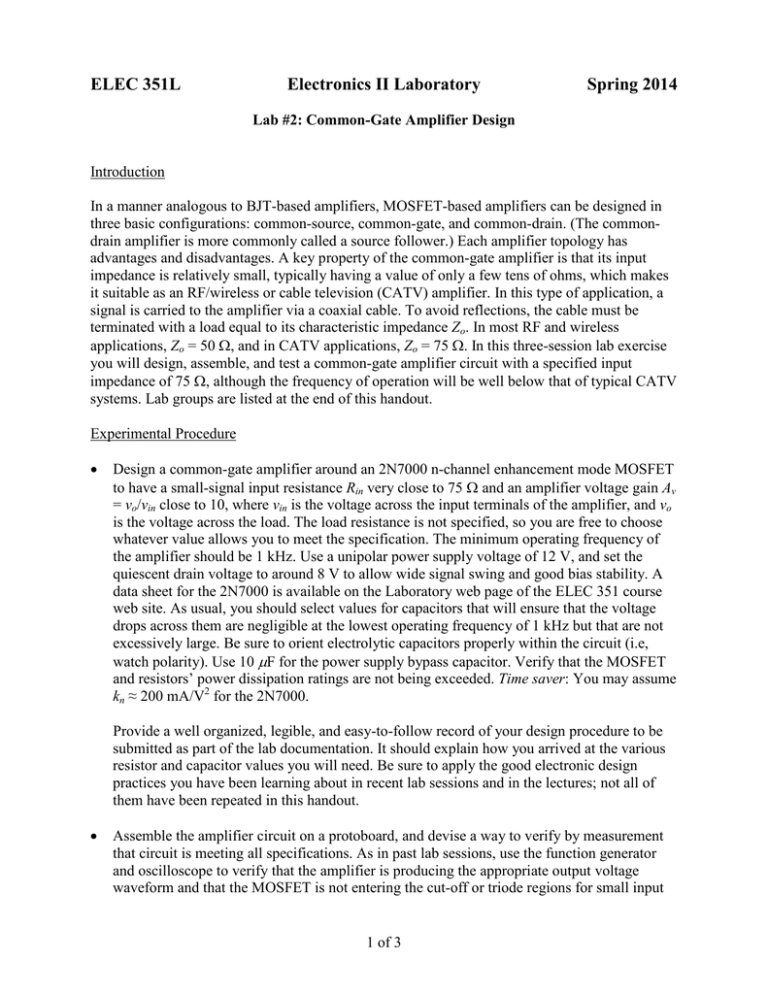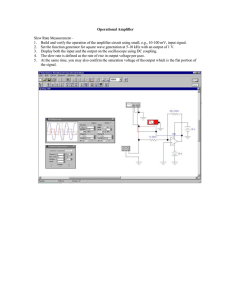Lab #2 - Bucknell University
advertisement

ELEC 351L Electronics II Laboratory Spring 2014 Lab #2: Common-Gate Amplifier Design Introduction In a manner analogous to BJT-based amplifiers, MOSFET-based amplifiers can be designed in three basic configurations: common-source, common-gate, and common-drain. (The commondrain amplifier is more commonly called a source follower.) Each amplifier topology has advantages and disadvantages. A key property of the common-gate amplifier is that its input impedance is relatively small, typically having a value of only a few tens of ohms, which makes it suitable as an RF/wireless or cable television (CATV) amplifier. In this type of application, a signal is carried to the amplifier via a coaxial cable. To avoid reflections, the cable must be terminated with a load equal to its characteristic impedance Zo. In most RF and wireless applications, Zo = 50 Ω, and in CATV applications, Zo = 75 Ω. In this three-session lab exercise you will design, assemble, and test a common-gate amplifier circuit with a specified input impedance of 75 Ω, although the frequency of operation will be well below that of typical CATV systems. Lab groups are listed at the end of this handout. Experimental Procedure • Design a common-gate amplifier around an 2N7000 n-channel enhancement mode MOSFET to have a small-signal input resistance Rin very close to 75 Ω and an amplifier voltage gain Av = vo/vin close to 10, where vin is the voltage across the input terminals of the amplifier, and vo is the voltage across the load. The load resistance is not specified, so you are free to choose whatever value allows you to meet the specification. The minimum operating frequency of the amplifier should be 1 kHz. Use a unipolar power supply voltage of 12 V, and set the quiescent drain voltage to around 8 V to allow wide signal swing and good bias stability. A data sheet for the 2N7000 is available on the Laboratory web page of the ELEC 351 course web site. As usual, you should select values for capacitors that will ensure that the voltage drops across them are negligible at the lowest operating frequency of 1 kHz but that are not excessively large. Be sure to orient electrolytic capacitors properly within the circuit (i.e, watch polarity). Use 10 µF for the power supply bypass capacitor. Verify that the MOSFET and resistors’ power dissipation ratings are not being exceeded. Time saver: You may assume kn ≈ 200 mA/V2 for the 2N7000. Provide a well organized, legible, and easy-to-follow record of your design procedure to be submitted as part of the lab documentation. It should explain how you arrived at the various resistor and capacitor values you will need. Be sure to apply the good electronic design practices you have been learning about in recent lab sessions and in the lectures; not all of them have been repeated in this handout. • Assemble the amplifier circuit on a protoboard, and devise a way to verify by measurement that circuit is meeting all specifications. As in past lab sessions, use the function generator and oscilloscope to verify that the amplifier is producing the appropriate output voltage waveform and that the MOSFET is not entering the cut-off or triode regions for small input 1 of 3 voltage levels. Keep in mind that the input voltage of your amplifier must satisfy the smallsignal condition. You should use the high-quality probes with the oscilloscope. The value you obtain by measurement for Rin might differ from the target value by a relatively large margin, depending on what values you assumed for the MOSFET’s transconductance parameter kn and threshold voltage Vt. You may redesign the circuit to compensate for incorrect values if you wish. Include a brief description of your input resistance measurement procedure and the value you measured in your lab documentation. If you redesigned the amplifier for any reason, include the initial Rin measurement along with your final Rin measurement. • After you are satisfied that your input resistance measurement method is working properly and that the voltage gain is correct, demonstrate your circuit and input resistance measurement to the instructor or TA. Demonstrations will be observed on a first-come, firstserved basis. The deadline for the demonstration is 9 pm Monday, February 24. • Capture an oscilloscope screen image of the input and output voltage waveforms, and determine the voltage gain from your measurements. Compare the measured gain to the estimated gain determined by small-signal analysis, and comment on the results. Be sure to record any relevant additional data or test conditions such as the frequency of operation. Include the screen image and your voltage gain calculations in your lab documentation Lab Documentation After your group has completed the demonstration, compile the following items into a single document. Introductory and concluding sections are not required, but the documentation should be well organized and include the group members’ names, the course number (ELEC 351), the submission date, and the lab number. • • • • Design steps for the CS amplifier circuit (with circuit diagram) and justifications for all resistor and capacitor values used. Description of input resistance measurement procedure with results. Screen capture of the input and output voltage waveforms with frequency specified and appropriate annotations included. Comparison of gain derived via measurement to target gain, including reasons for any significant discrepancies. Include a brief discussion of implications of results. The documentation must be in MS-Word (*.doc or *.docx) format and must be submitted via the course Moodle site by 11:59 pm on Monday, March 3. The file size must be less than 5 MB. One copy per group should be submitted. Documentation will not be graded directly for writing mechanics, spelling, and grammar, but it must be legible and understandable. Documentation may be handwritten on notebook paper if it is then scanned or photographed and inserted into the MS-Word document. Minimize the file size by using appropriate camera or scanner settings (e.g., black & white and 300 dpi for scanning). Keep a copy of your documentation if you wish to use it to prepare for the next exam. 2 of 3 Grading Each group member will receive the same grade based on the following criteria. Scores will be quantized at the indicated percentage levels. 0, 15, 30, 45, 60% 0, 2, 5, 8, and 10% each Demonstration of properly operating circuit Bulleted items listed in the “Lab Documentation” section Lab documentation submitted after the deadline will have a 10% grade deduction applied for every 24 hours late, although credit for successful assembly and demonstration (60% maximum) will be given regardless of when the documentation is submitted. If the demonstration is not completed by the end of the third lab session, it may be completed later, but a 10% grade deduction for each additional 24 hours will be applied. No demonstration credit will be given five days or more after the end of the third lab session. Group Assignments The randomly generated groups for this lab exercise are listed below: Ononuju-Kwiatkowski Opalinski-Hontz Hough-Brown MacGibbon-Hecht Goesseringer-Bekampis-Bennett © 2013-2014 David F. Kelley, Bucknell University, Lewisburg, PA 17837. 3 of 3

